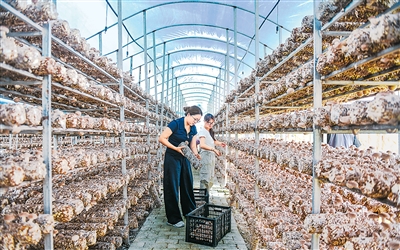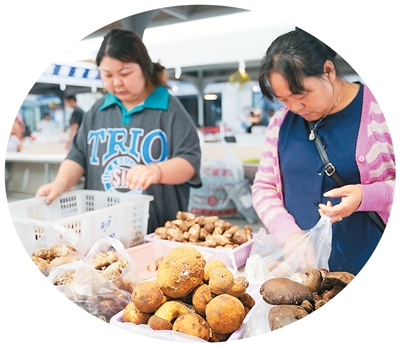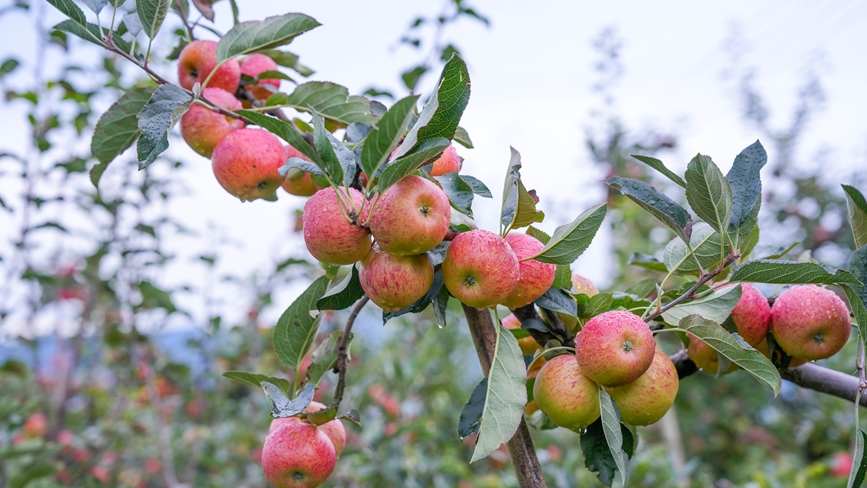China becomes world's largest producer, consumer of edible mushrooms

Workers harvest shiitake mushrooms at a company facility in Anlong county, Qianxinan Buyi and Miao Autonomous Prefecture, southwest China's Guizhou Province. (People's Daily/Liu Chaofu)
China has become the world's largest producer and consumer of edible mushrooms, according to Cao Hui, a researcher at the Research Center for Rural Economy under the Ministry of Agriculture and Rural Affairs.
China produces more than 40 million tonnes of edible mushrooms annually, representing over 70 percent of global output for multiple years running. The industry generated more than 380 billion yuan ($53 billion) in value last year, official data shows.
Within China, Henan, Fujian, Heilongjiang, and Hebei provinces have become major centers for edible mushroom production and distribution, while Yunnan Province leads in edible wild mushrooms.
The Mushuihua Wild Mushroom Trading Center in Kunming, capital of Yunnan, is the province's largest wild mushroom marketplace. Transactions there account for 85.7 percent of the province's total mushroom trade, with daily volumes exceeding 30 tonnes since the onset of the rainy season this year.
"Since our establishment in 2005, we've sold a cumulative 342,600 tonnes of edible wild mushrooms," said Cheng Aili, the center's general manager.
Yunnan's mushrooms have gained international recognition, with Japanese consumers particularly valuing matsutake varieties from the Diqing, Lijiang and Dali regions. South Korean buyers favor Sarcodon aspratus mushrooms from Chuxiong, while European and American markets show strong demand for the province's chanterelle and saffron milkcap mushrooms.

Merchants sort wild mushrooms at a trading center in Nanhua county, Chuxiong Yi Autonomous Prefecture, southwest China's Yunnan Province. (Photo/Liang Zhiqiang)
Nanhua county in Yunnan, known for its abundant wild mushroom resources, boasts a forest coverage rate of 71.77 percent and more than 1,000 identified edible wild mushroom species. The overlapping of mushroom harvesting season with summer tourism has boosted mushroom-picking tours and agricultural tourism.
Ye Yuxuan manages tours and guides mushroom identification in Longchuan town, Nanhua county. "This summer, our base welcomed numerous groups of visitors. We guide them up the mountains for mushroom-picking experiences, then prepare a specialty wild mushroom hot pot with their harvest," Ye said.
Nanhua has created specialized mushroom tour routes and partnered with Kunming public transportation authorities to create dedicated two-day tours. The county hosts three tour groups daily on average, with accommodation often fully booked. "Mushroom-tourism integration" has become central to the county's industry strategy.
The mushroom industry's potential extends beyond fresh produce. Processing now creates mushroom-based snacks, sauces, beverages and seasonings, significantly increasing value.
In Suizhou city, central China's Hubei Province — renowned for "Suizhou shiitake" — deep-processed products such as shiitake sauce, seasoned shiitake, concentrated shiitake juice, and ready-to-eat snacks make up over 80 percent of the city's mushroom exports. The city now produces more than 30 varieties of processed shiitake products.
"Through intensive processing, ordinary dried shiitake mushrooms can see their export value increase by 15 to 20 percent," said Yao Chi, general manager of Hubei Taiyuan Industrial Co.
The company extracts shiitake polysaccharides and polypeptides through multi-stage processing, significantly boosting product value. It produces polysaccharide tablets and beverages, and plans two new extraction lines this year, targeting 500 tonnes of annual output.
Mushroom cultivation requires skilled workers, sufficient funding and advanced equipment. The industry increasingly relies on technology for improved seed conservation, functional breeding and targeted cultivation programs.
The rise of new marketing approaches such as livestream e-commerce has greatly expanded sales channels for edible mushroom products, while cross-border e-commerce platforms have opened new trade opportunities, Cao observed.
Edible mushrooms are gaining popularity among health-conscious consumers as a source of amino acids, proteins and dietary fiber.
Edible mushroom industry development is central to China's comprehensive agriculture and food strategy.
The State Council issued guidelines last September promoting food supply diversification, specifically targeting the mushroom industry for development and product expansion.
This year's "No. 1 central document" further emphasized improving the quality and efficiency of the sector.
"In talent development, China's 2025 undergraduate programs include majors in Fungal Science and Engineering as well as Edible Mushroom Science and Engineering. In standards development, the country has issued more than 20 national and agricultural standards for edible mushrooms and promoted key standardized production technologies in advantageous regions in recent years," Cao said.
China has supported 11 provinces, including Shanxi, in surveying agricultural microbial resources, including mushrooms, to enhance resource collection, Cao said.
Cao called for aligning with international standards, building strong brands and accelerating processing upgrades to promote mushroom industry development.
Photos
Related Stories
- Cutting-edge technologies boost edible wild mushroom industry in SW China's Yunnan
- Wild mushrooms hit the market in SW China's Yunnan
- Tremella mushroom cultivation in Gutian, SE China's Fujian, contributes to global development
- 15,000 pictures of tremella mushrooms set Guinness World Record in Gutian, SE China's Fujian
- Tremella mushroom industry thrives in county of SE China's Fujian
- Farmers find big fortune in truffles in SW China's Yunnan
- Mushroom exhibition held at Latvian Museum of Natural History in Latvia
- County in SE China's Fujian leads tremella mushroom production, lifting rural incomes
- Feature: Mushroom-themed tours emerge as popular summer-vacation option
- Edible wild mushrooms pave way to prosperity in Nanhua county, SW China’s Yunnan
Copyright © 2025 People's Daily Online. All Rights Reserved.









